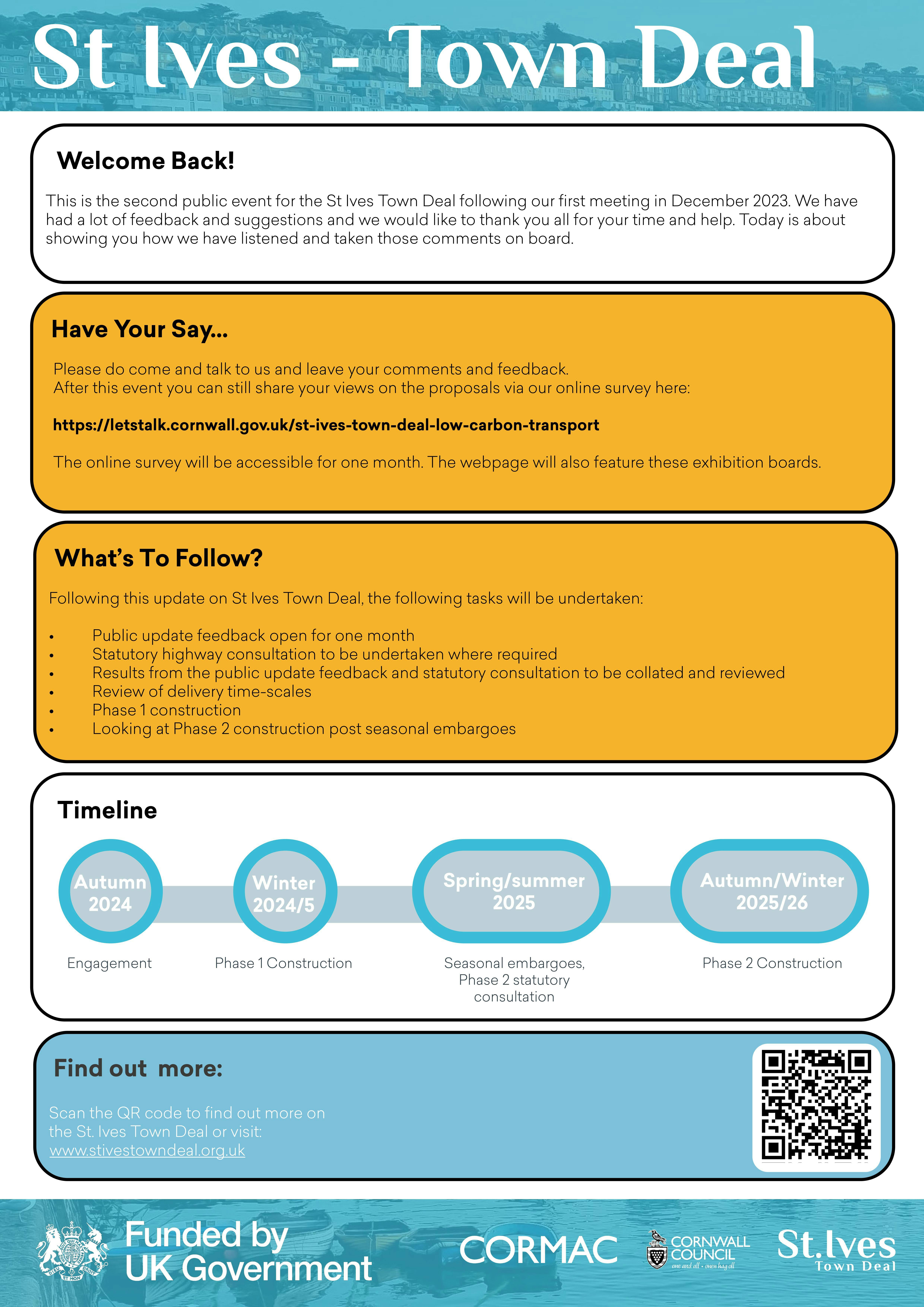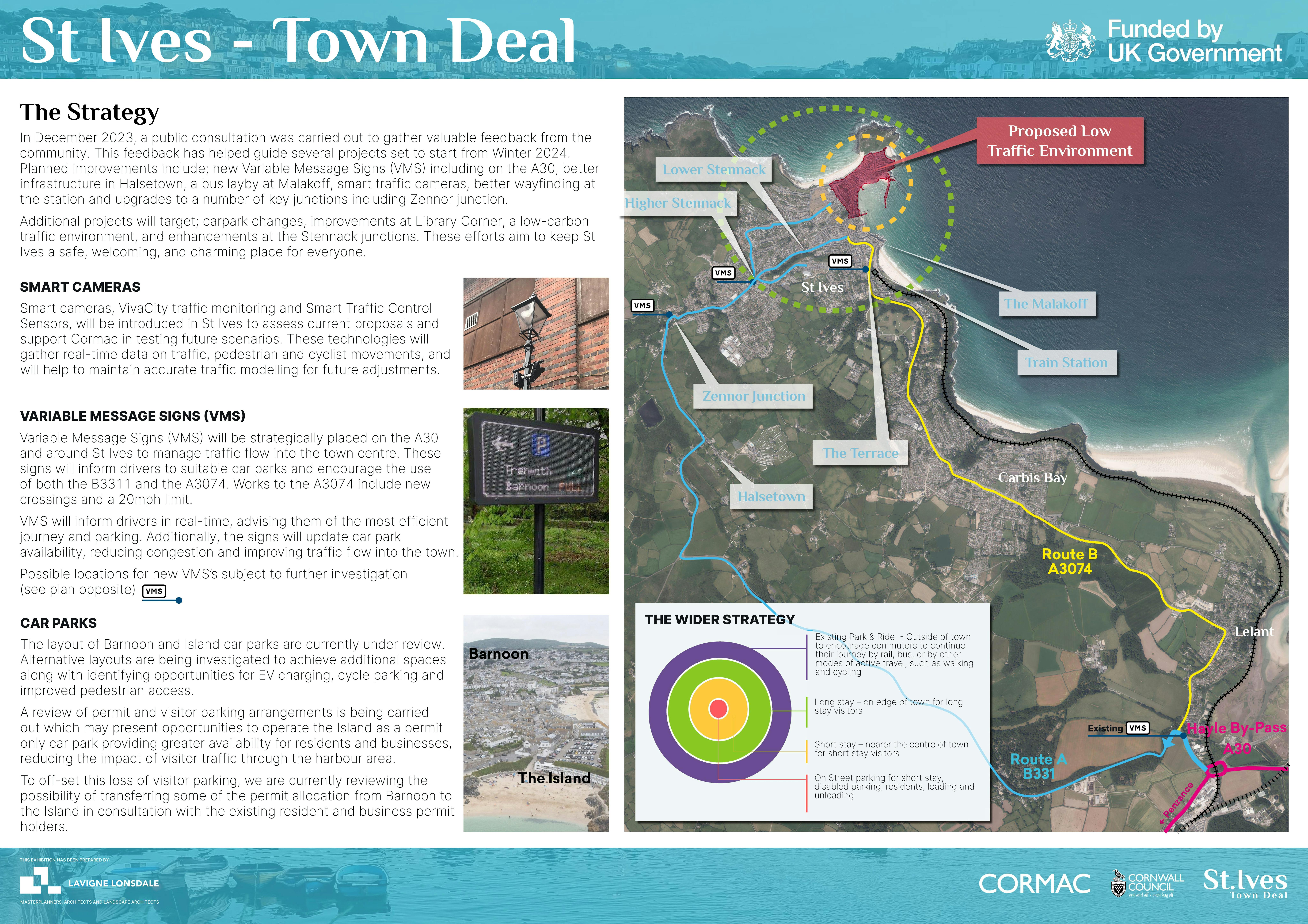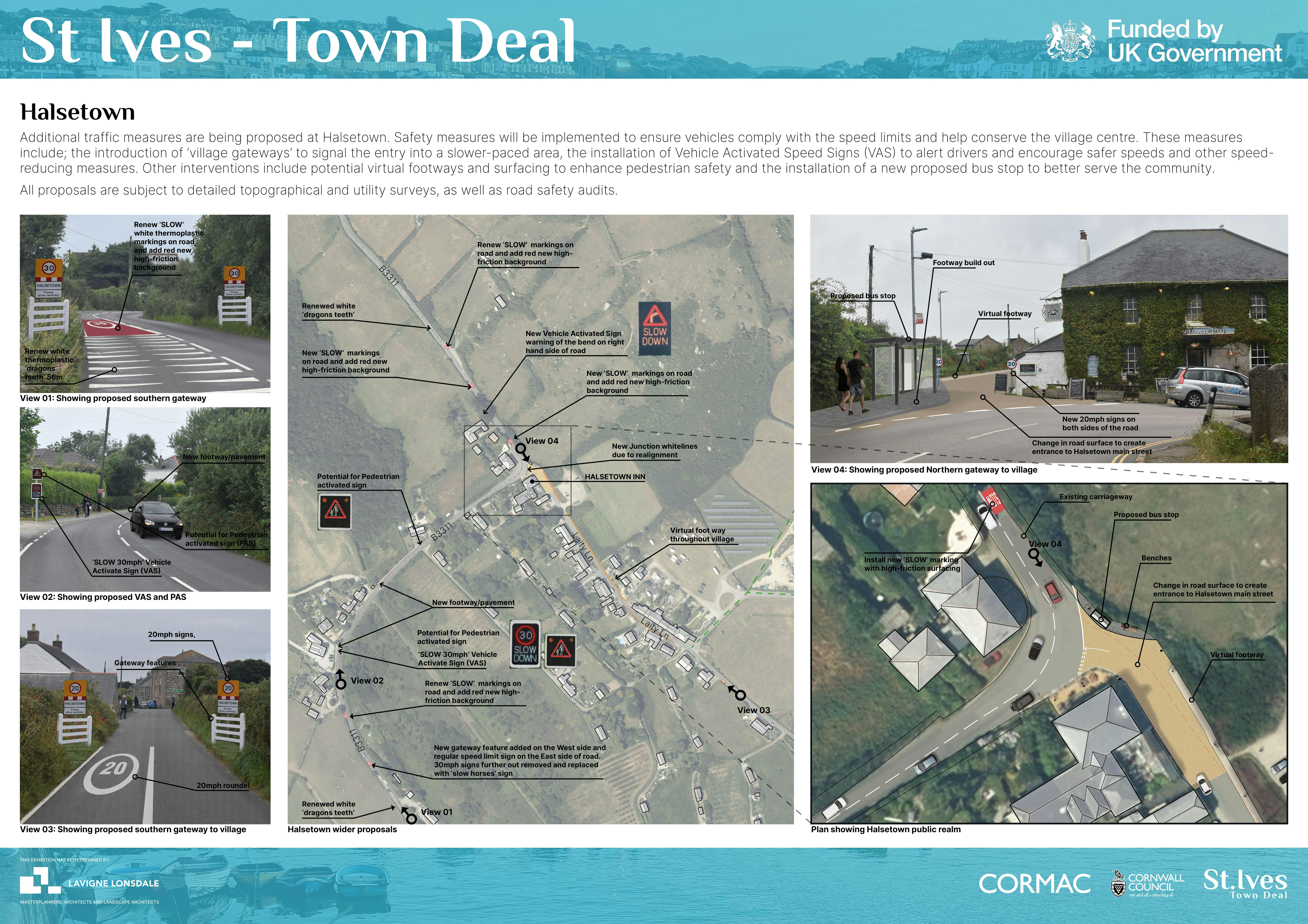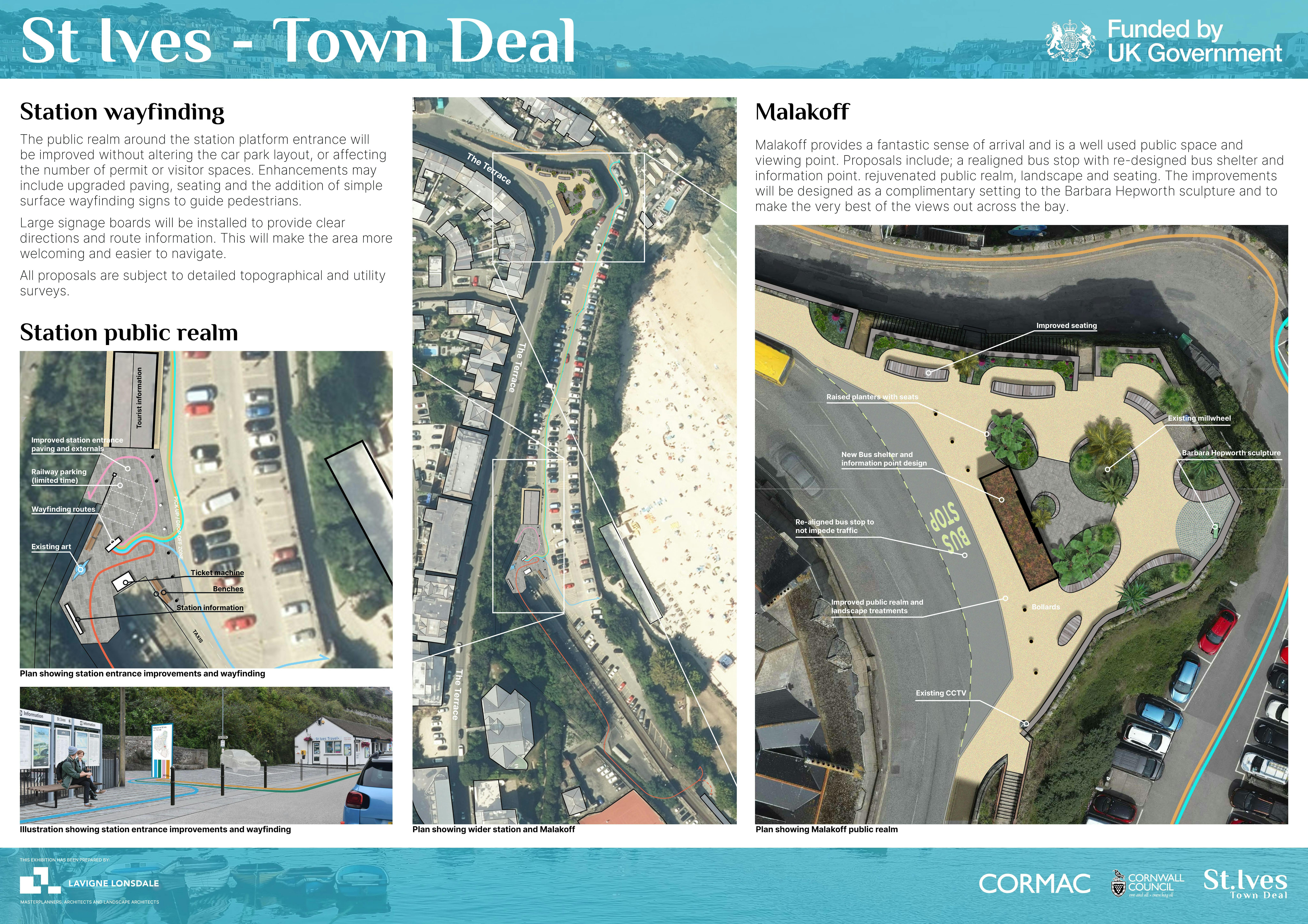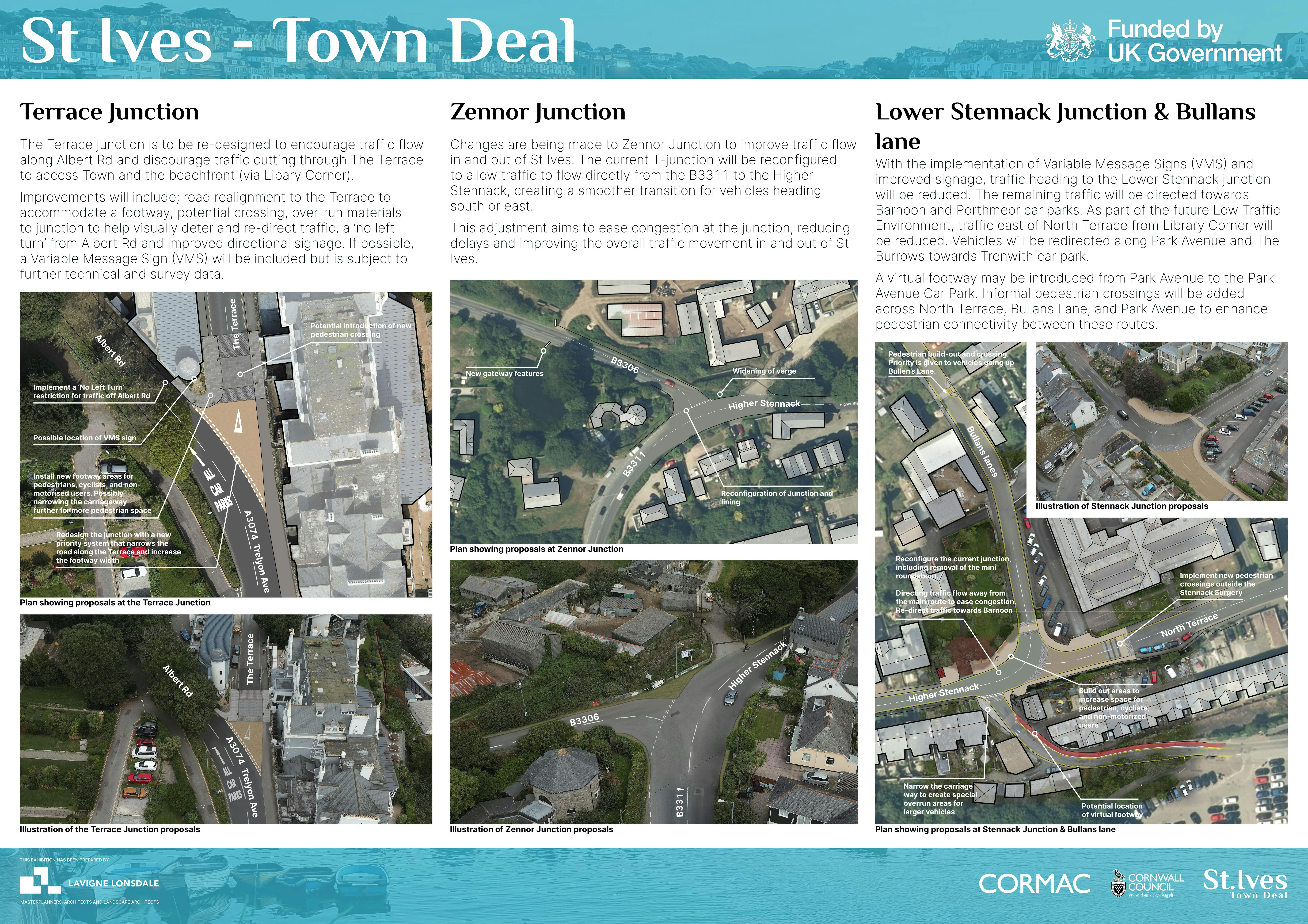St Ives Town Deal Low Carbon Transport
Latest News
Update on the Malakoff scheme 18 December 2025
This week, the team has made further progress on the foundations for the new seating areas. Two timber shutters have been constructed for the granite benches, including the second-largest shutter, with plans to pour both concrete bases later this week—weather permitting. Ducting routes are now in place from the chambers to the bench locations, ready for future cable installation. In addition, one gully pot has been installed and connected to the drainage system, improving site infrastructure.
From everyone working on the Malakoff project, we’d like to wish everyone a very Merry Christmas and a Happy New Year! Thank you all for your continued support as we create a space for everyone to enjoy in 2026.
Update on new road layout scheme 2 December 2025
A huge thank you to everyone who has been supporting the new traffic restrictions in the centre of the town since the changes to the road layout came into operation.
It has been really positive to see the vast majority of drivers abide by the restrictions on driving down Tregenna Hill from The Terrace. The marshals have done a great job in reminding people that only buses, cyclists and emergency services are now legally able to drive down the hill since the scheme was introduced and we hope that the local community will continue to support us by following the new changes over the coming weeks.
Drivers have also been getting used to the reversal of the one way at Park Avenue and we would particularly like to thank the residents for the way in which they have dealt with this change.
We will continue to monitor the flow of traffic through the town centre and the level of compliance with all the measures so we can make any changes if needed.
You can watch a short video about how the scheme has been working here https://youtu.be/uqUKzLMBSWM
Providing feedback
Thank you to everyone who has already filled in the survey on the specific Tregenna Hill ETRO webpage which has been set up on Let’s Talk Cornwall to provide information about the trial and enable people to raise feedback throughout the trial period.
We need as many people as possible to provide their feedback (both positive and negative) on the trial so that all views can be taken into account when a decision is made on a permanent scheme at the end of next year.
The survey will remain open throughout the whole duration of the trial.
You can access the page here
Signage
We are aware of concerns over some of the initial signage and are working with the Council’s highways team to address this by increasing the size of some of the signs and adding additional ones where required. New temporary signs will be installed in key areas over the next few weeks.
Pedestrian and Cycle Zone
We are also aware of some confusion over the operation of the Pedestrian and Cycle Zone on Tregenna Place.
The introduction of the Zone means that the only vehicles permitted to drive on Tregenna Place between 10am and 4pm are those who reasonably cannot avoid such access.
People who need to access their home or business, including holiday accommodation, CAN still do so between 10 am and 4 pm provided they are driving directly to the premises. This includes being able to pick up or drop off passengers or luggage if this reasonably cannot be done in any other way.
Reasonable access also extends to those with a recognised disability and are holders of a blue badge.
You do not need a licence or permit to drive on Tregenna Place to access your property or business, but you will be expected to drive directly to your destination and to be considerate of other road users, particularly pedestrians.
This restriction is not intended to materially affect access for those in the community that need it, however we would ask you consider wherever possible avoiding such access between the restricted hours.
The aim is to make this busy area of the town centre safer for pedestrians and cyclists by reducing the number of vehicles using this stretch of road.
Please note that the previous restriction on Chapel Street, which prohibits general vehicles from using the road apart from access remains in place. This means that only vehicles accessing properties on, or only reasonably accessible from, Chapel Street, should use this road.
Quick reminder about other measures in the scheme :
Other changes which are now in operation include:
- Changing Albert Road from two way to one way towards Park Avenue
- No right turn at the bottom of Bedford Road
The trial does not affect any of the private or public car parks in the town. This means people can still part at:
- Trenwith Car Park (next to St Ives leisure centre) – this car park has the largest capacity, with a shuttle bus in operation between Royal Square and the car park at seasonal times. To leave the car park and exit the town to Carbis Bay you need to head straight ahead on the Burrows to the mini-roundabout junction with Higher Stennack. Turn right towards The Stennack and follow the signs to Carbis Bay.
- Park Avenue Car Park (on Park Avenue).
- The Station Car Park (accessible from The Terrace),
Both the car park on Tregenna Hill and the car park on Skidden Hill remain accessible from The Terrace. However it not possible to reach the town centre when exiting from these.
The disabled parking bays on Gabriel Street remain in place.
Further information on the ETRO scheme, including copies of key documents, is available at https://letstalk.cornwall.gov.uk/st-ives-town-deal-etro
Ends
Update on the Malakoff
As the project moves towards Christmas and into the New Year, people will be able to see the refurbishments begin to transform the Malakoff into a welcoming space for everyone to enjoy.
Local specialists are currently fabricating the steel fixings needed to secure the Mill Wheel in place when it’s returned to its rightful place. Cormac’s skilled masonry team will be carrying out repairs to the outer wall of the Malakoff, as well as laying granite sett paving. Once the paving is complete, a resin-bound surface will be poured in the central area, framed by the granite setts.
Towards the end of the scheme, following the installation of new power distribution equipment by Enerveo, illuminated granite benches and bollards will be installed and connected. Landscaping and planting will be carried out in spring 2026.
This week the team has completed the installation of ducting routes in readiness for the next stage of construction. Excavation for the new foundations is now underway, and timber shuttering is being carefully built in preparation for pouring the concrete bases in the coming weeks.
Every step brings the transformation closer to being completed and the reinstatement of the Epidauros II sculpture in its rightful place.
NEW ROAD LAYOUT IN ST IVES IS NOW IN OPERATION
Just a reminder that the new road layout in the centre of the town is now in operation.
Cyclists and emergency services (including lifeboat crews on active duty) are permitted to drive northbound down Tregenna Hill from The Terrace. All traffic can still drive southbound up Tregenna Hill.
Albert Road has changed from two way to one way towards Park Avenue
Reversal of the one-way at Park Avenue, allowing inbound traffic only towards Bullans Lane and the Doctors surgery
Tregenna Place – introduction of Pedestrian and Cycle Zone with authorised vehicles only between 10 am and 4 pm
No right turn at the bottom of Bedford Road
A specific Tregenna Hill ETRO webpage has been set up on Let’s Talk Cornwall to provide information about the trial and enable people to raise feedback throughout the trial period.
You can access the page here
Regular updates will be posted during the trial.
Update on the Malakoff Scheme - 14 November 2025
The first phase of works, running from October through to Christmas, is progressing well despite the challenging weather conditions. The site has now been fully cleared, with the historic mill wheel carefully removed and set aside for future use.
The project team have excavated down to a level that will allow the foundations to be installed for the new seating. Drainage has been successfully installed, and the majority of electric ducting is now in place. These ducts will power the integrated lighting for the bespoke granite benches, which are designed to enhance the area, whilst providing somewhere to sit.
Earthworks will then be carried out in readiness for the installation of the granite paving and planters, plus, of course, the return of the iconic Epidauros II sculpture by Dame Barbara Hepworth.
The project remains on track to be completed by the end of May 2026.
Update on Tregenna Hill ETRO scheme
Thank you for all your comments. Below are answers to some of the questions raised over the past few days and a short video which provides more information about the changes.
You can view the video here https://youtu.be/QeQVg3cwjfU
The trial scheme will be introduced on Monday, 17 November. A specific Tregenna Hill ETRO webpage is being set up on Let’s Talk Cornwall to provide information about the trial and enable people to raise feedback throughout the trial period. This will go live at the launch of the trial. A link to this page will be provided on the launch date.
If you have any further questions please email traffic@cormacltd.co.uk
Why is the trial scheme being introduced
The current traffic movements on Tregenna Hill result in numerous daily conflicts between vehicles and pedestrians, impacting on everyone’s safety and user experience. The aim of the trial is to improve general traffic flow, resulting in a safer space for all users in and around Library Corner. The changes will also support the broader aims of the Town Deal Transport Strategy and the creation of a Low Traffic Environment in the town centre.
What is being proposed?
- Tregenna Hill – No Entry from The Terrace – except for buses, cyclists and emergency services (including lifeboat crews on active duty). All traffic will still be able to drive southbound up Tregenna Hill.
- Changing Albert Road from two way to one way towards Park Avenue, improving the flow of traffic and reducing traffic congestion and delays
- Reversing the current one-way at Park Avenue, allowing inbound traffic only towards Bullans Lane and the Doctors surgery
- Tregenna Place – introduction of Pedestrian and Cycle Zone with authorised vehicles only between 10 am and 4 pm
- No right turn at the bottom of Bedford Road
What are the benefits of the scheme ?
The general removal of northbound traffic down Tregenna Hill is expected to reduce the delays, impact and congestion caused in the current situation, whereby vehicles are having to navigate past each other in a highly constrained space.
This situation regularly leads to unavoidable vehicle manoeuvres that impact on safety such as awkward reversing movements and driving upon the footways. The changes will also make it easier for buses, lorries and other large vehicles to get around the narrow points and corners along the route.
The reversal of traffic flow along Park Avenue will help to reduce a potential network pressure up over the Burrows to the Stennack, past Trenwith Car Park and Leisure Centre. By providing a route for local traffic, the reversal will help maintain a balance of vehicles on the road network in this part of the town.
Will the changes reduce the level of traffic at Library Corner
Although supported by the wider transport strategy measures, this trial alone is unlikely to reduce the overall amount of traffic at Library Corner. However, the imposed restrictions on Tregenna Hill, mean that general traffic will only be flowing in one direction, reducing the opportunity for conflict to occur, creating a more controlled environment.
How long will the trial last
The trial will remain in place for at least six months but is likely to be extended up to 12 months to include the summer season before a final decision is made.
How will you ensure drivers understand the changes?
New signs are being installed at key roads and junctions informing drivers of the changes and new restrictions, providing details of alternative routes into and out of St Ives. During at least the first week of the trial, traffic marshals will also be in place at key locations to help support drivers who may be unaware or unsure of the change.
Can I access my holiday accommodation through the Pedestrian and Cycle Zone (on Tregenna Place)?
Yes, you may access rented premises – including to pick up or drop off passengers or luggage. You are encouraged to be considerate of other road users, including pedestrians, during busy times.
Can I drive through the Pedestrian and Cycle zone (on Tregenna Place) to access on the road parking
No, only the conveyance of persons, goods or merchandise (if these can’t be reasonably conveyed other than by vehicle) directly to or from premises is permitted. Please note that the Island area of St Ives is also a restricted parking zone.
Can I, or my visitors, access my residential property through the Pedestrian and Cycle Zone (on Tregenna Place)?
Yes, residential and visitor access directly to premises is still permitted.
Can I use Chapel Street to access the town centre (bypass the Pedestrian and Cycle Zone)?
No, there is an existing Prohibition of Motor Vehicles (except for access) restriction on Chapel Street, which will still be in effect during the trial. Therefore, only vehicles accessing properties on, or only reasonably accessible from, Chapel Street, should use this road.
Are there alternative travel options into the town?
There is a Park & Ride service from St Erth train station, and regular buses services from other nearby towns. You can find information on available bus services at: www.transportforcornwall.co.uk/services
What will happen to the disabled parking bays on Gabriel Street?
The disabled parking bays on Gabriel Street will be maintained.
I’m visiting St Ives, where can I park?
Any of the currently available private or public car parks – this trial does not affect their use.
The main car parks are: The Station Car Park (accessible from The Terrace), Trenwith Car Park (next to St Ives leisure centre) and Park Avenue Car Park (on Park Avenue).
Please note that Trenwith Car Park has the largest capacity, and a shuttle bus service between Trenwith Car Park and the Town Centre (Royal Square) is available at seasonal times.
From Trenwith Car Park, how can I exit St Ives to Carbis Bay?
From Trenwith Car Park, head straight ahead on the Burrows to the mini-roundabout junction with Higher Stennack. Turn right towards The Stennack and follow the signs to Carbis Bay.
Why were traffic lights not used at Library Corner?
The use of traffic lights was fully considered; however, these were not proceeded with due to technical challenges and potential to cause greater level of traffic congestion within the town.
Can I access the THCP Ltd Car Park on Tregenna Hill, or the Car Park on Skidden Hill from The Terrace?
Yes, These car parks remain accessible from The Terrace. However, it will not be possible to reach the town centre when exiting from these.
What is the ETRO process?
The use of an ETRO means that Cornwall Council as Highways Authority can make modifications throughout the trial period, responding agilely to specific issues or concerns that are observed.
This will provide greater chance for success, with both community feedback and engineer analysis shaping the ultimate decision making as to whether the trialled changes are made permanent or not.
New road layout to be trialled in St Ives
Changes to the current road layout on Tregenna Hill in the centre of St Ives are to be trialled from 17 November.
From Monday, 17 November only buses, cyclists and emergency services (including lifeboat crews on active duty) will be permitted to drive northbound down Tregenna Hill from The Terrace. All traffic will still be able to drive southbound up Tregenna Hill.
You can watch a short video about the trial here
Please email traffic@cormacltd.co.uk with any questions about the ETRO trial.
The general removal of northbound traffic down Tregenna Hill will reduce the current delays, impact and congestion created by vehicles having to navigate past each other in a highly constrained space. The changes will also make it easier for buses, lorries and other large vehicles to get around the narrow points and corners along the route.
There are currently numerous daily conflicts between vehicles and pedestrians using this stretch of road. Previous community consultations have identified this area as one of the main highway concerns for the local community, but it is also one of the more complex environments to implement an effective solution.
Following significant appraisal, technical assessment and broad engagement, a new road layout has now been designed.
The aim of the trial, which will be implemented via an ‘Experimental Traffic Regulation Order’ (ETRO), is to improve traffic flow and reduce these daily conflicts.
While the trial alone is unlikely to reduce the overall amount of traffic at Library Corner, ensuring that general traffic will only be flowing in one direction will significantly reduce the opportunity for conflicts to occur. This will create a more controlled environment and provide a safer space for all users in and around Library Corner.
The changes will also support the broader aims of the Town Deal Transport Strategy and the creation of a Low Traffic Environment in the town centre.
New signs will be installed at key roads and junctions informing drivers of the changes and new restrictions and providing details of alternative routes into and out of St Ives. During at least the first week of the trial, traffic marshals will also be in place at key locations to help support drivers who may be unaware or unsure of the change.
Other measures being introduced as part of this trial include making Albert Road one-way inbound, improving the flow of traffic and reducing traffic congestion and delays, introducing an entry restriction on the western end of Dove Street and a mandatory left turn at Street-an-pol. There will also be no right turn at the bottom of Bedford Road.
The direction of the existing one-way at Park Avenue will also be reversed, allowing inbound traffic only towards Bullans Lane and the Doctors surgery. This will help to keep traffic moving along this route, reducing the numbers of queuing stationary vehicles.
This change is intended to deliver several specific benefits for residents of Park Avenue including:
- Potential reduction in the number of vehicles using Park Avenue
- Reduction or removal of the local buses, a long-standing aspiration of residents
- Create opportunity to consider further restriction of larger vehicles by decreasing the current weight restriction
The change to the traffic flow along Park Avenue will also help to reduce a potential network pressure up over the Burrows to the Stennack, past Trenwith Car Park and Leisure Centre, as a consequence of the proposed trial changes.
By providing a route for local traffic, the reversal will help maintain a balance of vehicles on the road network in this part of the town. This will be closely monitored throughout the trial.
The use of an ETRO means that Cornwall Council as Highways Authority can make modifications throughout the trial period, responding agilely to specific issues or concerns that are observed.
This will provide a greater chance for success, with both community feedback and engineer analysis shaping the ultimate decision making as to whether the trialled changes are made permanent or not.
A specific Tregenna Hill ETRO webpage is being set up on Let’s Talk Cornwall to provide information about the trial and enable people to raise feedback throughout the trial period. This will go live at the launch of the trial on 17 November. Regular updates will be posted throughout the trial.
The project team will be encouraging feedback from all sectors of the local community, as well as visitors to the town, during the trial to enable the performance of the scheme to be fully determined. This feedback, along with active monitoring by transport engineers, will be used to shape the decision on a permanent scheme.
The ETRO has been developed by Cornwall Council in partnership with St Ives Town Deal Board, with technical expertise provided by Cormac. Engagement with key stakeholders, including St Ives Town Council, transport operators and providers and emergency services, has influenced the development of the new road layout which is now being trialled.
The trial is being funded through the St Ives Low Carbon Transport Strategy and will remain in place for at least six months but could extend up to 18 months before a final decision is made.
Please email traffic@cormacltd.co.uk with any questions about the ETRO trial.
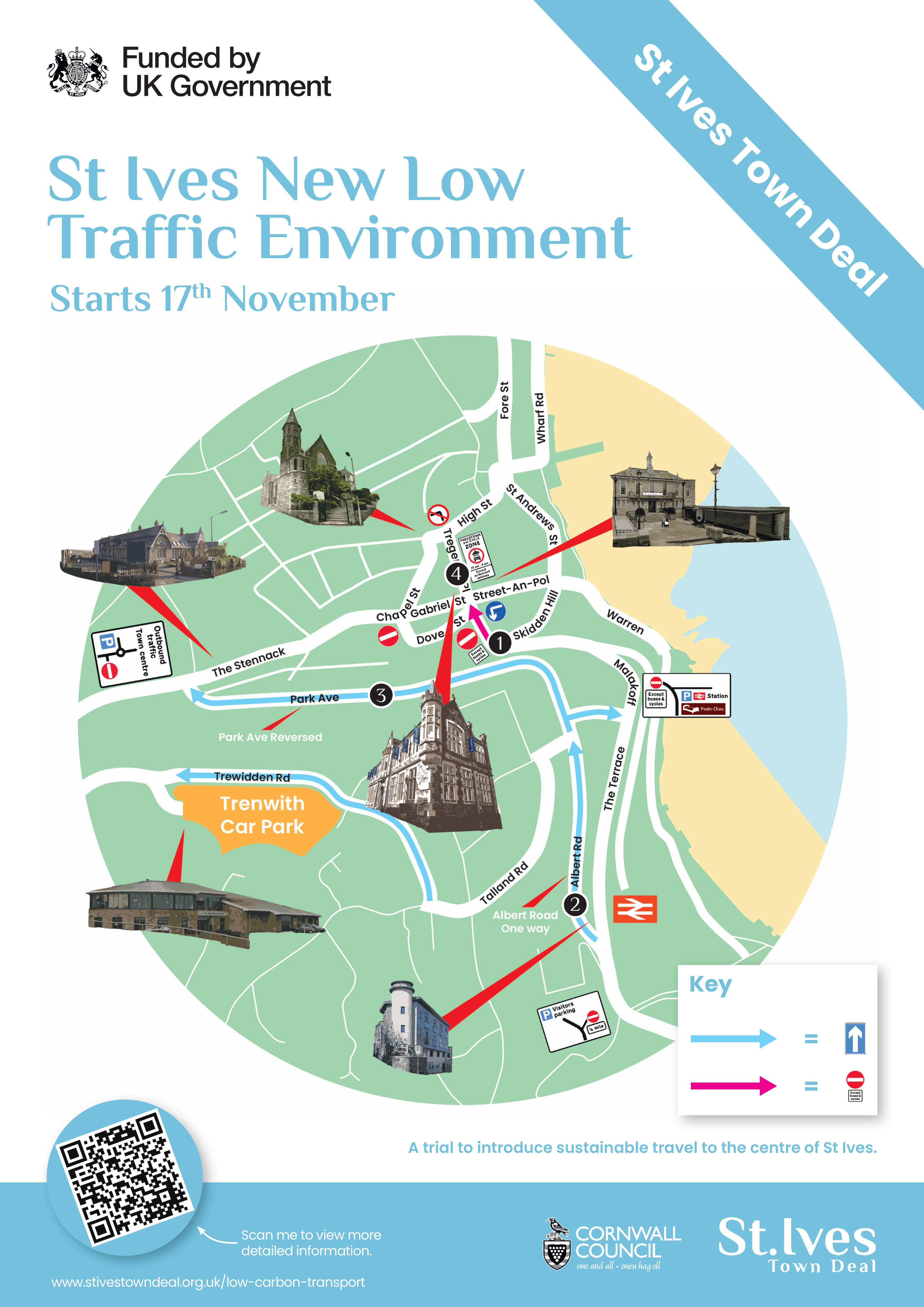
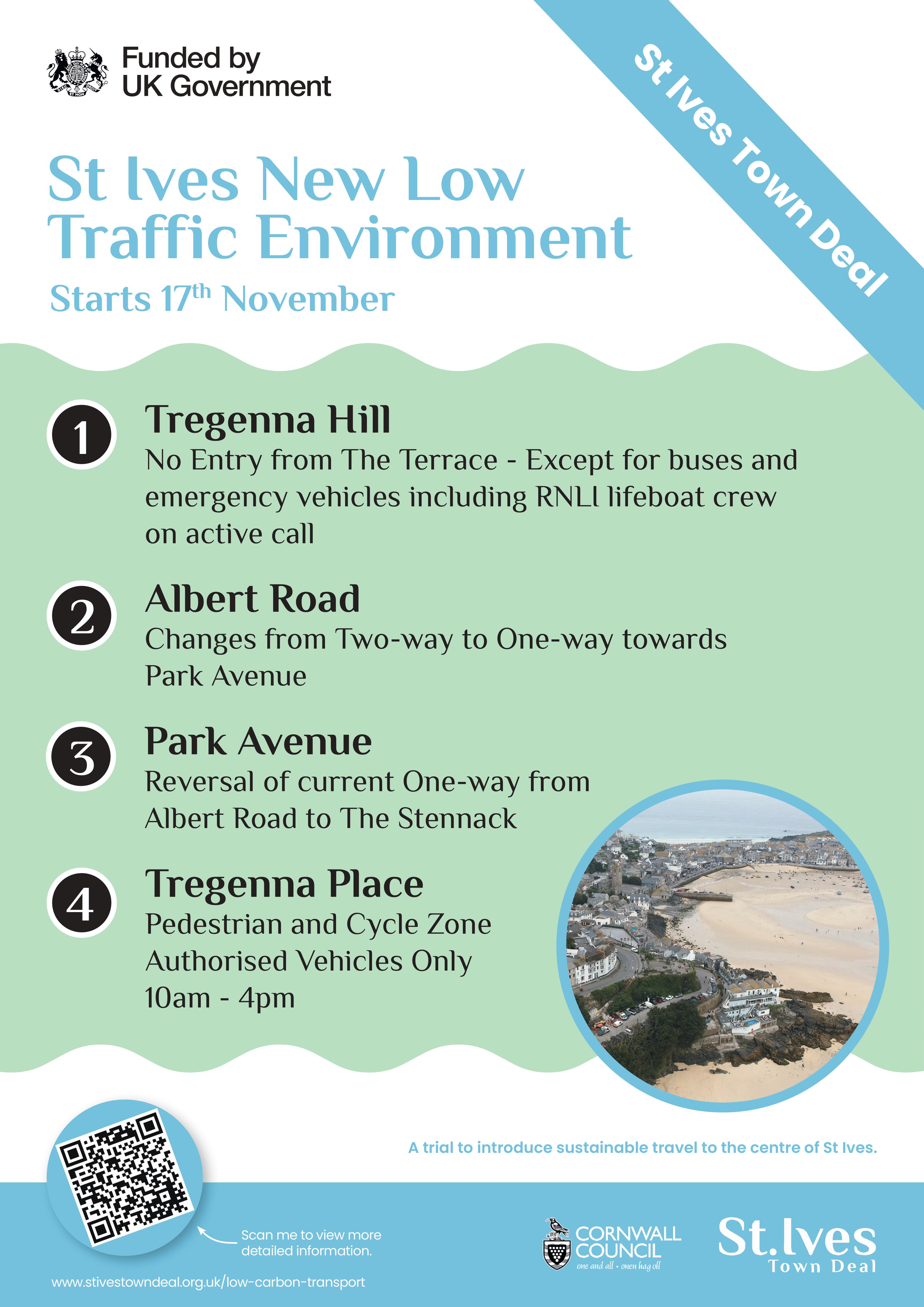
Work to begin on final phase of Malakoff open space scheme
Work on the final phase of the scheme to improve the Malakoff open space in St Ives began in October.
The first phase, which included the creation of a new bus layby and footway, was completed earlier this year. Repairs have also been carried out on the car park steps and nearby parapet wall which were damaged by vehicle collisions.
Since then the project team have been working with stakeholders and the local community to finalise the designs for the second phase of the scheme which will include the provision of a new bus shelter, seating, paving and landscaping.
Following approval of the designs by the Town Deal Board and St Ives Town Council, work began on delivering this final phase of the improvements on Monday, 6 October. Construction is expected to take up to six months to complete.
The first stage, which will be carried out between October and Christmas, will see work taking place to clear the site and install new drainage and structural foundations.
A new bespoke bus shelter will then be constructed, together with new granite paving, bespoke granite planters and benches, new street furniture, a new millwheel feature and lighting.
Once the iconic sculpture Epidauros II by Dame Barbara Hepworth, which was temporarily relocated to the Penwith Gallery during the works, has been returned to its rightful home at the Malakoff, the area will be fully resurfaced.

Plans for next two Sustainable Transport schemes in St Ives finalised
Plans to provide new signs and landscaping around Tempest Roundabout near Lelant and improve the area at Higher Stennack to make it safer for pedestrians to cross the road have been finalised following consultations with the local community.
Following improvements to the Park & Ride at St Erth, the existing signage at the Tempest Roundabout is now out of date.
The scheme includes the renewal of road markings and removal of the outdated signs. These will be replaced by new signs directing drivers to St Ives via the B3311 and towards St Erth Park and Ride instead of Lelant Saltings Station.
These changes will support the wider traffic management strategy which is being developed for the town and help ease the pressure on the wider local road network at peak times.
New plants will also be added to the flowerbeds and grassy areas around the roundabout.

The improvements at Higher Stennack include the installation of an informal crossing point between the mini-roundabouts, providing a new seating and cycle parking area and replacing one set of speed cushions with a flat top hump to make it easier to cross the road at this point.
The scheme also involves moving two streetlights to ensure signs are visible and open up more space for pedestrians, replacing the paving at crossing points with dropped kerbs and installing correctly aligned tactile paving. These changes will help people with visual impairments and make it easier and safer for those with pushchairs or in wheelchairs to cross the road.
Plans are being developed to update signs in the area as part of a wider sign strategy for the town. This will be published for consultation later this year as part of an experimental traffic order (ETRO).


Work is also progressing well on developing the other schemes within the Low Carbon Transport Strategy.
Following the completion of the Terrace scheme, the improvements to Consols junction and the first phase of the Malakoff open space scheme, work has now been completed on delivering the first phase of the scheme to reduce traffic speeds and improve pedestrian safety at Halsetown.
Plans are also being finalised for the scheme to improve the management of traffic at Tregenna Hill and Library Corner. The scheme, which will be trialled using an Experimental Traffic Regulation Order (ETRO), is currently due to be introduced in November after the end of the busy summer season.
The Strategy, which has been allocated £5.5 million of Town Deal funding, includes proposals aimed at reducing traffic congestion and parking demand in the town centre, enhancing public transport options and accessibility, improving air quality and health outcomes for residents and visitors, and supporting local businesses by creating a more attractive and vibrant town.
Update on Consols Junction scheme
Work on re-designing Consols junction on the B3306 to reduce travel times on the route into St Ives by changing the priority of the junction and improve pedestrian access was completed by the end of March.
A preliminary design for Consols junction was presented at the public update event held in St Ives Library in September 2024. Following engagement with local residents, the original design was amended to include a new pedestrian footway to create a safer place to walk along the narrow pinch point past Tom’s Yard and additional pavements around the junction.
As well as changing the priority of the junction, to give priority to traffic flowing between St Ives and Halsetown rather than St Ives and Zennor, the works include a priority give-way system, where traffic leaving St Ives has priority over vehicles entering. Following the completion of these works, the junction was fully resurfaced and new road markings applied.
Key milestone for St Ives as work is completed on first Low Carbon Transport Strategy scheme
St Ives has celebrated another milestone as work is completed on the first highways scheme to be delivered as part of the Town Deal funded Low Carbon Transport Strategy.
Andrew Baragwanath, Chair of St Ives Town Deal Board, was joined by Cornwall Council Leader Linda Taylor and Louis Gardner, Cabinet Portfolio Holder for Economy, St Ives Mayor Johnnie Wells, project manager Charlotte Nash, from Ward Williams ,and Tom James, from Cormac, at the Terrace where work has been carried out to re-design the junction to improve pedestrian access and space, and discourage visitors from driving into the town centre.

The scheme, which has been constructed by Cormac, has involved widening the existing footway on the northwest corner of the junction, by the St Ives Harbour Hotel, and changing the current signs and road markings to direct people towards Trenwith car park rather than driving into the town.
Members of the public were consulted on plans in October 2024, with the feedback used to shape the final design for the scheme.
Welcoming the completion of the scheme, Andrew Baragwanath, Chair of the St Ives Town Deal Board, said “ It is great to see these much needed improvements provided at the Terrace. This is a busy junction and I would like to thank all the partners who worked together to minimise disruption during the construction and ensure that the scheme was completed as quickly as possible”.
“The aim of the Transport Strategy is to reduce the impact of vehicles on St Ives and introduce measures that encourage walking, cycling and the use of public transport. “This scheme, which will make the area safer for pedestrians and help to discourage traffic from going through the town, is the first to be carried out as part of the Transport Strategy and I look forward to seeing further schemes delivered in the coming months”.
Cornwall Council Leader, Linda Taylor said: “As a St Ives resident, I know it feels like this investment has been a long time coming. In truth, Town Deal funding has allowed us to engage extensively with local people to understand their priorities and I know I am not alone in looking forward to enjoying our beautiful town even more as traffic is directed away from its centre.”
Louis Gardner, Portfolio Holder for Economy, Cornwall Council added: “St Ives is a hive of activity with Town Deal projects at the moment with more to come over the next 15 months, and investment in transport plays a key role in knitting it all together. These works are a particularly welcome component in driving traffic in the right direction around the town.”
St Ives Mayor Johnnie Wells added “ For as long as I can remember traffic has been a nightmare in St Ives, and the last few seasons have been beyond chaotic. Reducing the number of vehicles in town is the key to improving accessibility in St Ives and the Town Deal project has given us the funds and resources to think big and really get something done. I am so proud to be part of this project that has the potential to transform our town for the better... this is the first step towards that goal."
Engagement event 11 September 2024
More than 400 people attended the St Ives Low Carbon Transport Strategy update event on 11 September 2024 to find out the latest details about all the projects which are being developed and the timetable for delivering the different elements.
You can view a video about the update event here :
:
One of the nine Town Deal projects being funded and delivered as part of the St Ives Town Deal programme, the aim of the Low Carbon Transport Strategy is to help reduce the impact of vehicles on St Ives and introduce measures that encourage walking, cycling and the use of public transport.
The Strategy, which has been allocated £5.5 million of Town Deal funding, includes proposals aimed at reducing traffic congestion and parking demand in the town centre, enhancing public transport options and accessibility, improving air quality and health outcomes for residents and visitors, and supporting local businesses by creating a more attractive and vibrant town.
The individual projects which make up the Strategy are being delivered in phases, with local statutory consultation taking place ahead of the plans being implemented.
Work on the first phase is due to begin later this year. This includes the installation of a new Variable Message Sign on the A30 and around St Ives to help manage traffic flow into the town centre. Currently installation is due to commence by the end of this year, these signs will advise drivers of the most efficient journey and parking before they enter the town. As well as providing real time information on car park availability, the signs will encourage drivers to use St Erth P&R. Work is currently taking place to identify locations for all of the new signs.
Smart traffic cameras are also being introduced throughout the town to provide real time information on the quantity and types of vehicles, pedestrians and cyclists entering the town centre. Due to be installed in 10 to 12 sites over the next three months, these cameras will be used to help the project team monitor the effectiveness and benefits of all the changes resulting from the implementation of the strategy. The data will also be used to identify where additional measures might be required in the future to help support or improve the traffic environment and wider traffic management.
Other projects which will be implemented include improvements to the junctions at Malakoff, Lower Stennack, Zennor and the Terrace aimed at improving traffic flow within the town and enhancing bus and train user experience, improving safety for pedestrians and cyclists, and achieving greater speed compliance.
Work on improvements to the junctions at Zennor and Terrace are currently expected to begin in January 2025, with the schemes at Malakoff, which will include realigning the bus stop with provision of a bus shelter and information point, enhancing the gardens and providing additional seating, and Lower Stennack due to begin in September 2025.
This phase also includes potential changes to the layout and operation of some of the car parks in the town with the aim of reducing the number of visitors driving through the town centre.
A review of permit and visitor parking arrangements is currently being carried out which may present opportunities to operate the Island as a permit only car park. As well as reducing the impact of visitor traffic through the harbour area, this change would provide additional permits for residents and businesses.
To off-set this loss of visitor parking, the project team are also reviewing the possibility of transferring some of the existing permit allocation from Barnoon to the Island. While there is overall support for the principle of reducing visitor traffic in the town centre, following concerns from existing permit holders at Barnoon, additional work is taking place to investigate the potential for changing the current layout of the car park to provide additional spaces. No decisions have yet been made, with further engagement due to take place with permit holders over the coming months.
Further work is also taking place to identify measures to mitigate the potential impact of additional traffic on the local community in Halsetown following concerns about the potential increase of more holiday and day visitor traffic into St Ives along the old coach road .These include the introduction of ‘village gateways’ to signal the entry into a slower-paced area, the installation of Vehicle Activated Speed Signs (VAS) to alert drivers and encourage safer speeds and other speed reducing measures. Other interventions include potential virtual footways and surfacing to enhance pedestrian safety and the installation of a new proposed bus stop to better serve the community.
Once detailed topographical and utility surveys and road safety audits have been carried and potential costings identified for the proposed measures, further engagement will take place with the local community to confirm the final programme. It is currently hoped to start work on implementing the agreed measures after the Zennor junction scheme has been completed in early to mid 2025.
The second phase of the Strategy, which includes the creation of a Low Traffic Environment and related improvements at Library Corner and Royal Square, are currently due to be implemented in late 2025 / early 2026.
The aim of the LTE is to reduce unnecessary vehicles from traveling along Wharf Road and Fore Street. Following the public consultation in 2023 and the decision not to use physical restrictions / barriers to prevent access to the town centre, this will now be achieved through the use of signed restrictions only preventing unnecessary traffic from driving into the town centre during peak times through the summer season. Local residents and businesses will not be affected by the restrictions. Improvements will also be made to the streetscape and public realm to discourage visitors from driving into the town centre and improve safety for pedestrians.
Other changes being made as part of the LTE include upgrading Royal Square, a key arrival point in the town, to make it more welcoming. These plans are still being developed but are expected to include providing designated zones and spaces for buses, loading and taxis, creating a new distinctive gateway to the town, installing bike storage facilities and providing continuous footways to improve safety for pedestrians.
The final project involves improving the management of traffic at Tregenna Hill and Library Corner. The current two -way layout results in numerous daily conflicts between vehicles entering and leaving the town via this route and between vehicles and pedestrians, causing significant congestion and delays. Previous consultations have identified this as one of the main areas of concern for the local community.
Following concerns over the impact of the original proposal for a one-way traffic system on bus and emergency services (including lifeboat crews), further work is being carried out on the design. A potential solution which would maintain the proposed one-way system and provide access for bus and emergency services through traffic lights at the top and bottom of the hill and the use of additional technology, has been identified.
However, the complexity of this area means that more work is needed to ensure that the change would improve the current situation and not create additional problems elsewhere on the local road network.
Local statutory consultation will be required before work starts on each of the individual projects. Regular updates will be provided on the St Ives Transport Strategy page on the Let’s Talk Cornwall site : https://letstalk.cornwall.gov.uk/st-ives-town-deal-low-carbon-transport.
Copies of the boards are available to view below :
There is also a feedback format the bottom of this page to give your views on the latest proposals.
:







You can watch a short video about the strategy here
The Town Deal funding has to be spent by March 2026, with the projects due to be delivered in phases over this period. Any longer-term measures will need to be funded from other sources.
.You can stay updated on the development of this project and the Town Deal programme in St Ives by joining the online newsletter - Subscribe me to the newsletter.
About the Transport Strategy for St Ives
Funded and delivered as part of the St Ives Town Deal programme, the project aims to:
• Reduce traffic congestion and parking demand in the town centre.
• Improve air quality and health outcomes for residents and visitors.
• Enhance public transport options and accessibility for all.
• Support local businesses by creating a more attractive and vibrant town.
You can view the full exhibition and proposed plans here.
About the St Ives Town Deal
St Ives was one of four locations in Cornwall selected to bid for the Government’s £3.6b Towns Fund, which aims to drive economic regeneration and level up the region’s economy.
St Ives secured a Town Deal of up to £19.9m in June 2021, after submitting a Town Investment Plan that outlines nine projects to revitalise the town.
To implement the plan, St Ives Town Deal Board collaborates with funded partner organisations and Cornwall Council.
Six of the nine St Ives Town Deal projects have now been contracted and received their first grant payments, enabling work to begin on delivering these exciting and ambitious schemes. These include St Ives Theatre, the Rugby Club Relocation and Housing, the Guildhall, Leach Pottery, the Enterprise Grants and St Ives Community Orchard.
These projects are part funded by the Government's Town Deal programme and delivered by Cornwall Council in partnership with the St Ives Town Deal Board.
More information is available on the St Ives Town Deal website www.stivestowndeal.org.uk
You can also follow the St Ives Town Deal programme on social media.







